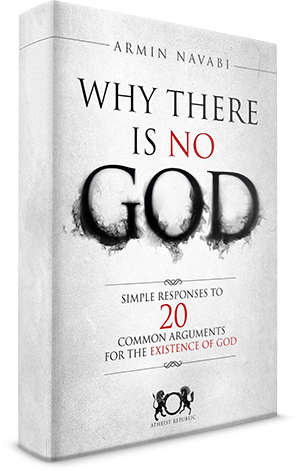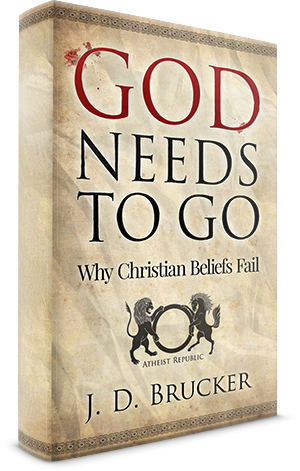
The vast majority of Christians would answer this question affirmatively, viewing it as pure provocation or a merely rhetorical question. In the former case, they would probably indignantly not answer it at all, in fact.
However, when compared to a proper monotheistic religion like Judaism as described in the Torah (if we disregard the couple of instances where a 1st person plural indicates many deities in the place of one ‒ Genesis 3:22 and 11:7 ‒ there is no pluralis majestatis in Hebrew), we can see many traits of Christianity that a proper monotheist would abhor.
Trinity
The idea of one being three and three being one is far removed from a monotheistic vision of a deity. It is true that the Hebrew appellation for their deity, אֱלֹהִים (Elohim), is a masculine plural form of the word we know as the Arabic name for the Muslim god, ألله (Allah). The Christians are ready to explain that this plurality of the divine appellation indicates the three persons of their own Trinity. The Jews would disagree and retort that the plural only mirrors their deity’s greatness. (Just like the name of the beast בְּהֵמוֹת ‒ Behemoth, also a morphologically plural form, this one feminine ‒ reflects its enormousness.) Mythology historians, on yet another hand, would probably suggest that the Semitic god אֵל (El), originally allegedly a bovine deity, absorbed more and more duties of other deities until it remained the sole one acting as many deities in one. (This prolonged historical episode might have been illustrated in the Bible by the considerably shorter myth of the Golden Calf.) Thus its singular appearance and plural nomenclature.
The idea of a Trinity leading the Pantheon is more an Indo-European one. In Hinduism we find the Trimūrti (Sanskrit “three forms”), the concept in which the cosmic functions of creation, maintenance, and destruction are personified by the forms of Brahmā the creator, Viṣṇu the maintainer or preserver and Śiva the destroyer or transformer. More familiar to us is the triad leading the Olympian gods of the Greek myths: Zeus, the supreme ruler, the god of sky and thunder; Poseidon, god of the sea and earthquaker; and Hades, god of the underworld; dividing their realms between the classical elements of air, water and earth respectively (fire is the one missing).
The French mythographer Georges Dumézil has proposed that in the world of the Proto-Indo-European society a tripartite ideology ruled, representing the function of sovereignty, the military function, and the function of productivity. In other words, the functions of the sacral, of the martial, and of the economic. This ideology would be then reflected in the Indian caste system ‒ the Brāhmaṇa or priests, the Kṣatriya or warriors and military, and the Vaiśya, the agriculturalists, cattle rearers and traders (the fourth one, the Śūdra, perform the function of serving the other three); as well as in the three divisions of the ideal society described by Socrates in Plato’s Republic ‒ philosophers, guardians, and producers; or in the three Norse gods ‒ Odin as the patron of priests and magicians, Thor of warriors, and Freyr of fertility and farming.
The Christian Trinity follows this pattern, with a paternal deity (God the Father), a filial deity (God the Son), and a maternal deity (the Holy Spirit, who in its original Hebrew form, ruach ‒ רוּחַ ‒ is feminine). Such a Trinity has been maintained throughout the history of Christianity with Mary slowly replacing the Holy Spirit in her (see? feminine!) functions, but not stepping into her place within the Trinity. This ascent of Mary from a minor and insignificant recurring character in the Gospels into an almost leading one in folk creed was pursuing the steps of her rising into a major mediator in today’s devoutness, gradually replacing the former, non-Christian and pre-Christian local God Mother deity in the believer’s worldview. (Just like one the most beautiful European orchids, the Venus Slipper, has become the Lady Slipper.)
Divine Progeny
Christians pleading for the introduction of “blasphemy” as a crime often forget that their own Jesus is blasphemy in the eyes of Jews. All humans are children of the God, but only in a metaphorical (or was it maybe metonymic?) sense. This idea is the result of the spreading of the original concept by which the kings of ancient Middle Eastern monarchies were customarily considered as adopted sons of the leading national deity, with the day of the coronation being the day on which they were “begotten” as such sons. Claiming to be a sole direct descendant from the deity in later Judaism has been simply unthinkable. Jesus’s mother Mary presents an even greater blasphemy to monotheists: the Mother of God! Not far from the concept of “mother” in Aldous Huxley’s Brave New World!
The idea of Jesus as a prophet seems to be alright. Islam even recognises him as such. Judaism as a false one, because nothing of what he prophesied became true. (On the other hand, it is not that all the canonical prophets in the Hebrew Bible had a record beyond reproach when it comes to foreseeing the future ‒ except in the cases when the prophesying was actually done after the predicted event itself.)
All aspects surrounding Jesus’s inception and birth are already well-known from older Mediterranean and Middle East religious and mythological traditions, a virgin mother, a deity as father, a conception with no actual sexual act, supernatural events marking the birth... Later, (the historical) Jesus(es?) did his best to compel with the prophecy he was well aware of, made by Isaiah and other Old Testament prophets, turning it into a prophecy of himself, “fulfilling” it thus just by following the already described steps that a proper Messiah should follow to be accepted as such.
Divine family relations, both with other deities and with ordinary humans, are a staple of every polytheistic mythology. Zeus has been notorious for being unable to keep it in his... well, whatever garment he was wearing at the time in that particular spot. Sometimes those relations are so complicated that one cannot even represent them in a graphical manner ‒ too many intersecting lines. The Christian one is rather simple in comparison, if we put aside the paternity question for the moment ‒ both God/Holy Spirit and Joseph are nominated as Jesus’s fathers.
Pantheon
Monotheistic religions either raise temples dedicated to their one deity or ‒ as Jews did ‒ raise a single temple for a single deity. It is not so with Christian churches. They are devoted to a vast number of individuals. Saints, beati, apostles, evangelists...
The hierarchy at the top is somewhat murky. The three persons of the Trinity seem to be struggling for the peak position. Ideally, God the Father should be on top and God the Son at the bottom, with the Holy Spirit mediating between them. However, God the Son has strived his way to the top, demoting God the Father to the typical post of Deus Otiosus, a Creator who after accomplishing his part of the bargain becomes an idle deity who largely retires from the world and is no longer involved in its daily operation (just like Eru Ilúvatar in Tolkien’s Middle Earth creation myth). The exact position of the Holy Spirit within the Trinity was hotly disputed in the past, and became the main reason (or at least the main motive) for the schism between the Eastern (“Orthodox”) and Western (“Catholic”) Churches (the filioque controversy).
Today’s position is probably best described by the movie director Luis Buñuel (“a nonbeliever thanks to god”) in his autobiography:
“Since we are talking about Christ, it seems to me that in the modern development of religion Christ took, little by little, a privileged position compared to the other two persons of the Holy Trinity. We talk only about him. God the Father still exists, but very vague, very remote. As for the luckless Holy Spirit, nobody cares about him anymore and he is begging at street-corners.” (Free translation of a translation of the original text by yours truly.)
Below the Trinity come the lesser deities of Christianity. Mary’s position is perhaps somewhere in between them and the Trinity, but as her cult is still developing, aided by numerous apparitions, ironically exclusively to people who already are believers (isn’t that a waste of apparition?), it is obvious that her career is still on a steady way upwards.
The twelve Apostles mirror not only the twelve tribes of Israel, but also the twelve Olympian gods of the Greek Pantheon. Twelve is, like sixty, a mathematically practical number that, unlike ten, can be divided in many different ways. On the other hand, twelve can be seen as a combination of two “sacred” numbers, the three and the four, as their product (as well as seven can be and was seen, as their sum). Hindus also have a dozen within their Pantheon, the Āditya, the twelve Sun Gods, one for each month of the year.
The four Evangelists seem to be somewhat lower in the celestial hierarchy, below the Apostles, but above the rest. It is still not clear whether two of them (John and Matthew) overlap with two of the Apostles. The number four, as already mentioned above, is also considered a sacred one.
All the deities mentioned so far are creatures of myth, no physical or historical evidence supports any hypothesis of them really being live individual humans in any point in history. The next category, a more numerous and less ordered one, mixes together names from legends and names of real persons, whose lives are documented in some way, and who rose to their present supernatural status after their death, or even because of their death. Promoting them into something more than men after death was probably fulfilling a deeply human need for justice. (“There is no justice. There is just me,” says Death in Terry Pratchett’s Discworld to the newly dead on multiple occasions.) The first saints were martyrs, individuals who have allegedly sacrificed their life in the name of what they believed. (Which makes their sanctity dubious, because doesn’t life belong to God and nobody else has the right to take it away or let it be taken away?) Later, Christianity became the ruling power that was killing others in the name of its religion, instead of letting itself be killed for the same reason. So the number of martyrs dwindled on the Christian side (and boomed on all the other ones) and Christianity had to look for its saints in other places. The process was progressively ritualised, and it seems that today nothing more is needed that a pope’s good will to proclaim someone a saint.
The numbers of saints (as the minor deities, those below the Trinity, are usually collectively called) is a huge one. Saints’ names not only fill up the Christian calendars worldwide, they literally overflow them. There are so many saints that some manage not to be worshiped but on a strictly local level. The situation becomes similar to the one of the Small Gods in (again!) Terry Pratchett’s Discworld: each god is as powerful as many followers it can gather.
To say nothing of the hordes of Seraphim, Cherubim, Thrones, Dominations, Virtues, Powers, Principalities, Archangels, and Angels!
And Christians pray to all of these deities, not only to the One God, and they build temples and shrines to all of them, and they held them all in high esteem.
So how can they call themselves monotheists?
In the light of everything brought forth above, it becomes clear that Satanism, of which Christianity seems to be afraid at least as much as of Harry Potter, is nothing but just another Christian denomination, the one that believes in Satan more than in any other of his colleagues in the Christian Pantheon.
Conclusion?
Isn’t Christianity then just a monotheistic religion (Judaism) adapted to the needs of a polytheistic populace (Roman) by a Jewish citizen of Rome, the tentmaker Saul of Tarsus, better known as St. Paul?





























